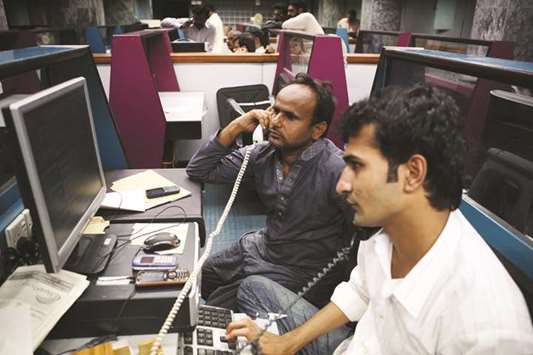Analysts are reckoning Pakistan Stock Exchange (PSX) to grow around 20% in 2018 despite getting hit by a negative benchmark index return of 15% to become the worst performing emerging market of 2017.
The benchmark KSE-100 index closed 2017 at 40,463.63 points, down from 2016’s closing of 47,806.97 points. With their net selling clocking in at $496mn in 2017, foreign sellers was blew a big hole in the market.
Foreigners now have an estimated shareholding of $6.5bn, which is 33% of the free float market and 9.0% of the total market capitalisation.
Analysts expect market to pare most of the losses of 2017, but not before the second half of the election year 2018, when the new government’s economic policies will kick in.
After recording strong gains during 2012-2016, where KSE-100 share index returned at a cumulative average growth of 33% soaring from 11,000 points to 48,000 points, the market has posted a significant decline in 2017. Previously the index lost 6.0% in 2011, while in crisis year of 2008 it lost 58%.
Adnan Sami at Topline Securities said 2017 turned out to be a tale of two halves for the benchmark index where the first half saw a bull-run fuelled by MSCI-EM inclusion euphoria pushing the market to a peak of 52,876 points on May 24, 2017 with a year-to-date gain of 11%.
“But, subsequent to that, things went south drastically, weight in MSCI-EM turned out to be lower than expected, foreigners sold instead of buying, federal budget was unfavourable, Panama Leaks led to the disqualification of Pakistan’s then Prime Minister, and economic shortcomings came under fire more than ever.”
Sami said the KSE-100 share index posted a gain of 46% in 2016. “Political, economic, and regulatory pressures led Asia’s best performing market in 2016 to become 2017’s worst performing market despite ample domestic liquidity,” he added.
Amongst the key sectors, cements, power generation, and commercial banks were the major laggards, while oil and gas exploration, textile composites and automobile assemblers turned out to be the outperformers in the market. On the other hand market capitalisation eroded 11%.
In terms of public offerings, the outgoing year was somewhat better than 2016 as three initial public offerings (IPOs) in 2017 raised Rs8.6bn, whereas an equal number of IPOs during 2016 generated only Rs4.2bn.
Due to deteriorating investment climate and some regulatory setbacks, some IPOs, scheduled for 2017, were delayed. They included offers of Inbox Business Technologies, a Dawood Group software house, Dalda Foods, a cooking oil brand, and AGP Pharma. These offers will likely come out in 2018 along with few others ie, Hira Textile Mills, TPL Corp (TPL), Unicol, Matco Foods, and Liberty Power Tech.
According to a survey conducted by JS Global Capital, the market finds the overall economic outlook to be neutral going forward with China-Pakistan Economic Corridor (CPEC) largely to have a positive impact on economy, while elections are expected in August 2018, and the idea of coalition government got most votes.
A report issued by Arif Habib views 2018 to be a year of reviving investor sentiment primarily drawing strength from diluting political uncertainty. “With the passing of the delimitation bill, elections are likely to be conducted on time.
Moreover, with the economy set to grow at a faster rate ie, 5.5%, we view foreign interest in the market is likely to recover,” the AHL report said.
The report added that an expected interest rate hike this year was likely to uplift earnings of the banking sector, which was the highest weighted sector while rupee depreciation will be a catalyst to the second highest weighted sector i.e., oil and gas exploration.
“Lastly, attractive valuations in the market are certain to attract the eyes of investors,” the AHL report added.
Analysts at JS Global Capital expect earnings announcements during the first half of 2018 to be relatively less exciting, while second half is likely to garner more interest as sectors with expansions, new projects coming online, and the ones that are sensitive to rupee depreciation and interest rates will come under the spotlight.
“We expect overall earnings growth to clock in at 11% in 2018, where oil and gas exploration companies are likely to take the lead on the back of higher oil prices, production additions, and currency devaluation,” an analyst said.
On the macroeconomic front, analysts anticipate fiscal deficit to potentially surpass the 6.0% mark, as public sector disbursements are likely to pick up ahead of the general elections.
In the first quarter of FY18 performance was somewhat impressive, with fiscal deficit hitting 1.2% of the GDP compared to 1.3% recorded in the corresponding period last year.
During the quarter, total revenues improved by 19% with total expenditures increasing by 13%. However, it is worth mentioning that in the fourth quarter of FY17, fiscal deficit reached at 2.1%, and a similar trend was predicted in the second half of this year as well.
As per news reports, IMF is also concerned over potential slippages in the fiscal account, where Pakistan has assured the mission that measures are being taken to control the deficit. Meanwhile, the government is looking to restart the privatisation process. The bottomline, however, is that market was unlikely to see much progress on the same before the elections.

Traders monitor stocks in a trading hall at the Karachi Stock Exchange in Pakistan (file). Analysts are reckoning Pakistan Stock Exchange to grow around 20% in 2018 despite getting hit by a negative benchmark index return of 15% to become the worst performing emerging market of 2017.


